Baking sheets are primarily designed for baking purposes, including cookies, pastries, biscuits, rolls, and more. They provide a flat and even surface for placing dough or other items in the oven.
Choosing the right sheet pan dinners or cookie sheets is essential for achieving great baking results. Here are some tips to help you make the best selection:

Material Of Baking Sheet
Consider the material of the nonstick cookie sheets. Aluminum, stainless steel, and aluminized steel are common options.
Aluminum heats up quickly and evenly, making it a good choice for most nonstick sheet needs.
Aluminum is a popular material in the world of baking due to its excellent heat-conducting properties. Here are some key reasons why aluminum is a preferred choice for many baking needs
Efficient Heat Conduction: Aluminum is an excellent conductor of heat. When placed in an oven, aluminum bakeware quickly absorbs and distributes heat evenly across its surface. This ensures that your baked goods cook uniformly, preventing hot spots that can lead to unevenly baked or burnt areas.
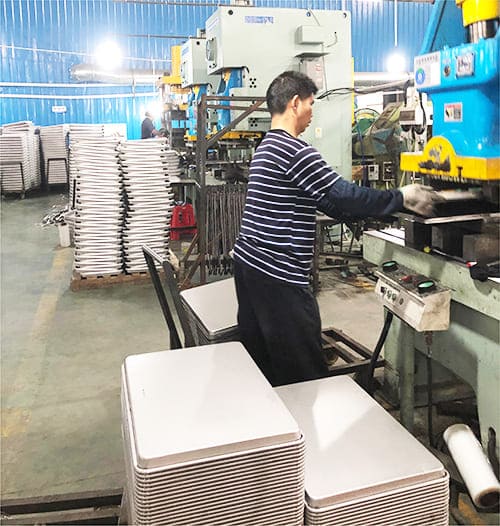
Quick Heating: Aluminum heats up rapidly, so your oven reaches the desired temperature more quickly. This can be especially advantageous when you’re in a hurry to bake something or need to maintain precise temperature control.
Even Baking: Because aluminum distributes heat evenly, it helps to achieve consistent results with your baked goods. Whether you’re making cookies, cakes, or bread, you can count on aluminum bakeware to promote even browning and a uniform texture throughout.
Lightweight: Aluminum is relatively lightweight compared to some other baking materials like cast iron or ceramic. This makes it easy to handle and maneuver in the kitchen, which is especially beneficial when transferring pans in and out of the oven.

Affordable: Aluminum bakeware is typically more budget-friendly than some alternatives like stainless steel or copper. It offers excellent performance without breaking the bank, making it accessible to a wide range of home bakers.
Non-Reactive: Aluminum is non-reactive, which means it won’t interact with acidic ingredients like tomatoes or citrus fruits. This is particularly important when baking items with acidic components, as it helps prevent off-flavors and discoloration.
Low Maintenance: Aluminum bakeware is easy to clean and maintain. It often has a nonstick coating or can be seasoned with a thin layer of oil to prevent sticking. Handwashing and gentle scrubbing are usually sufficient to keep aluminum bakeware in good condition.

Stainless steel is durable, resists rust and staining, and is suitable for high-heat applications.
Stainless steel is a versatile and popular material in the kitchen due to its durability, resistance to rust and staining, and suitability for high-heat applications. Here are some key characteristics and advantages of stainless steel in cooking:
Durability: Stainless steel is renowned for its exceptional durability. It is resistant to cracks, chips, and dents, making it ideal for heavy-duty use in the kitchen. This durability ensures that stainless steel cookware and utensils have a long lifespan, making them a cost-effective investment.
Rust and Corrosion Resistance: Stainless steel contains chromium, which forms a protective layer on the surface when exposed to oxygen. This passive layer makes stainless steel highly resistant to rust and corrosion. It can withstand exposure to moisture, acidic ingredients, and even salt without deteriorating, which is particularly important for kitchen equipment that comes into contact with liquids and food.

Stain Resistance: Stainless steel is also resistant to staining, which is essential for maintaining the aesthetic appeal of cookware and kitchen appliances. Even when cooking foods that are prone to staining, such as tomatoes or sauces, stainless steel surfaces are less likely to discolor or retain odors.
High Heat Tolerance: Stainless steel is capable of withstanding high temperatures, making it suitable for various cooking methods. You can use stainless steel cookware for searing, browning, and deglazing without worrying about warping or damaging the material. Additionally, stainless steel is often used in the construction of oven-safe cookware, allowing you to transition from stovetop to oven seamlessly.
Non-Reactive: Stainless steel is non-reactive, meaning it doesn’t interact with acidic or alkaline ingredients. This property is advantageous when cooking dishes that contain tomatoes, citrus, or wine, as it won’t affect the taste or color of the food.

Easy Maintenance: Stainless steel is relatively easy to clean and maintain. Most stainless steel cookware and utensils can be cleaned with soap and water or in the dishwasher. They are also less likely to retain odors or flavors from previous cooking sessions.
Aesthetic Appeal: Stainless steel has a sleek and modern appearance that complements a wide range of kitchen styles. It is a popular choice for both professional and home kitchens due to its timeless and professional look.
Versatility: Stainless steel cookware is versatile and can be used for a variety of cooking techniques, including sautéing, boiling, frying, and simmering. It’s suitable for both home cooks and professional chefs.
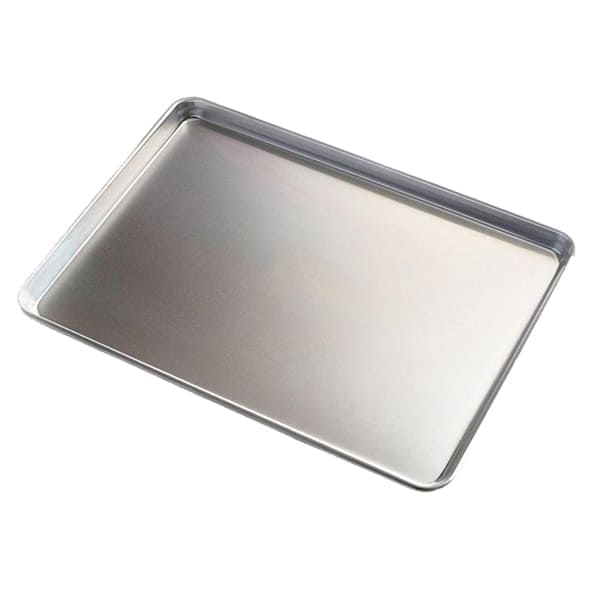
Aluminized steel combines the benefits of aluminum and steel, offering good heat conductivity and durability.
Heat Conductivity: Like aluminum, alusteel possesses good heat conductivity. It quickly and evenly distributes heat across its surface, ensuring that your baked or cooked items are evenly heated. This property is particularly valuable in baking, where even heating is essential for consistent results.
Durability: Alusteel inherits the durability and strength of traditional steel. It is resistant to dents, cracks, and scratches, making it a robust choice for kitchenware and other applications where durability is crucial.
Corrosion Resistance: Alusteel has excellent corrosion resistance, thanks to its aluminum-silicon alloy coating. This protective layer provides a barrier against rust and corrosion, even in high-moisture environments. As a result, alusteel is often used in automotive exhaust systems, where it must withstand corrosive elements.
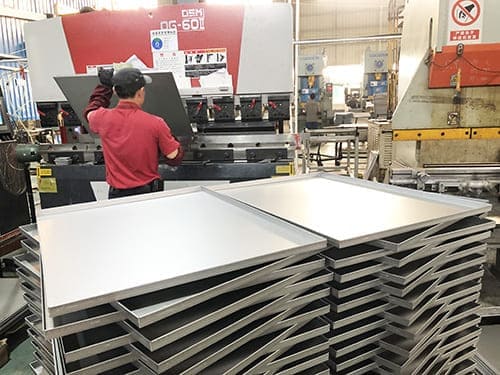
Non-Reactive: Similar to stainless steel, alusteel is non-reactive with food. It won’t impart any metallic taste or react with acidic or alkaline ingredients, making it safe and suitable for various cooking and baking tasks.
Cost-Effective: Alusteel offers a cost-effective alternative to some other materials like pure aluminum or stainless steel. It provides many of the benefits of these materials at a more affordable price point, making it an attractive option for both professional and home cooks.
Resistance to Warping: Alusteel is less likely to warp or deform under high heat compared to some other materials. This stability makes it suitable for applications that involve exposure to extreme temperatures, such as baking at high temperatures or automotive exhaust systems.
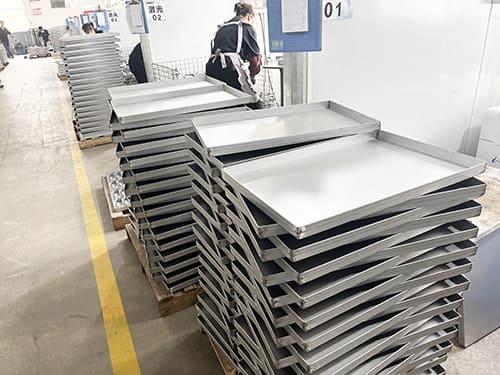
Ease of Cleaning: Alusteel surfaces are relatively easy to clean and maintain. They often have a nonstick or silicone-based coating, which helps prevent food from sticking and makes cleanup a breeze.
Versatility: Aluminized steel is versatile and can be used in various kitchenware and bakeware items, including cake pans, bread pans, and cookie sheets. It’s also used in industrial applications where heat resistance and durability are essential.
Thickness Of Cookie Sheets
Thicker best baking sheets tend to be more durable and less prone to warping. Look for sheets that are heavy-duty if you plan to use them frequently.
Size and Type Of Cookie Sheet
Determine the size and type of cookie sheets you need based on your baking preferences.
Standard baking trays are versatile and suitable for a wide range of recipes.
Jelly roll pan have raised edges and are great for rolled desserts.
Half-sheet pans are larger and ideal for commercial or large-batch baking.
Quarter-sheet pans are smaller and fit compact ovens.
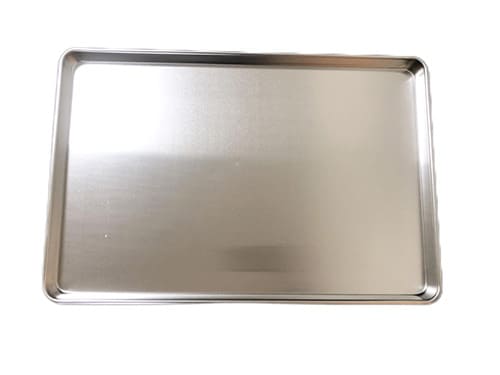
Edge Style Of Oven Cookie Pans
Consider whether you prefer cookie sheets with rolled edges or straight edges. Rolled edges provide extra durability and prevent warping.
Non-Stick Coating Of Sheet Trays
Non-stick coatings can make it easier to release baked cookies and simplify cleanup. However, they may wear off over time. If you choose non-stick, look for sheets with a durable coating.
Texture And Perforation Of Commercial Pans
Some baking cookies sheets have textured or perforated surfaces, which can promote better airflow and result in crisper baked goods. These are excellent for items like pizza crusts and French bread.
Rimmed or Rimless Of Oven-Safe Pans

Decide whether you want sheet pan with rims (raised edges) or rimless. Rims are useful for containing spills and preventing liquids from dripping off the edge.
Stackability Of Half Sheet Pans
If you have limited storage space, opt for baking sheet pan, jelly roll pan that are designed to stack neatly. This can save valuable kitchen cabinet space.
Compatibility Of Rimmed Aluminum Trays
Ensure that the baking sheet pan you choose are compatible with your oven size and baking equipment.
Budget Of Heavy- Duty Half Sheet Pan
Consider your budget when shopping for half sheet. While quality is essential, there are options available at various price points to suit different budgets.

Care and Maintenance
Be aware of the care and maintenance requirements of your chosen baking sheet. Some may be dishwasher safe, while others require handwashing.
Check for Evenness
Before purchasing, inspect the baking sheets for any warping or uneven surfaces. Flat sheets ensure even baking results.
Multiple Sets
If you do a lot of baking, consider investing in multiple sets of baking sheet so you can rotate them in the oven for even baking.
Remember that the choice of baking half sheet pan can significantly impact your baking outcomes, so take your time to select the ones that best suit your produce cookies needs and preferences. Proper care and maintenance will ensure that your nonstick jelly roll pan continue to perform well for years to come.

Where to Buy Baking Sheets
TM baking is a manuftacturer , supplys wholesale baking trays direct to all over the countries.
You can purchase baking trays from TM baking directly, If you’re looking for a specific type of sheet pan, such as a nonstick option, we recommend checking out our website and send a request get an instant quote.
Not only do we supply baking pans, but our wide range of complementary products such as aluminum bread pans , jelly roll pan, muffin pans, baguette trays, stainless steel bakery trolleys have been designed to meet all of the requirements of bakeries, kitchens and food manufacturing facilities.

More of The Best Sheet Pans That We Supply
TM Baking Natural Aluminum Commercial Baker’s Half Sheet: This sheet pan is made of pure aluminum, which ensures even baking and browning. It’s durable, warp-resistant, and perfect for various baking needs.
Baking Sheet Pan: Known for its heavy-duty construction, this sheet pan is ideal for baking cookies, pastries, and more. It has a non-stick surface for easy release and cleaning.
Sheet Pan Non Stick 400×600/460×660: Constructed with heavy-gauge aluminized steel, this pan provides even heat distribution and long-lasting durability. Its perforated surface design facilitates airflow for even baking.
Conclusion
In conclusion, selecting the right baking sheets or cookie sheets is a crucial step in achieving baking success. By considering factors such as material, size, and durability, you can ensure that your baked goods turn out perfectly every time. Whether you opt for aluminum, stainless steel, or non-stick coating, each type has its advantages depending on
the recipe and personal preference. Remember to invest in quality sheets that suit your baking needs, as they will contribute to even baking and easy cleanup. With the right baking sheets in hand, you can embark on your culinary adventures with confidence, knowing that you’re equipped to create delectable treats for yourself and others to enjoy.


